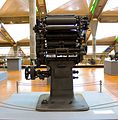Amiri Press

The Amiri Press or Amiria Press (Arabic: المطبعة الأميرية, المطابع الأميرية) (Al-Matba'a al-Amiriya) (also known as the Bulaq Press (مطبعة بولاق) due to its original location in Bulaq[1]) is a printing press, and one of the main agencies with which Muhammad Ali Pasha modernized Egypt.[2][3] The Amiria Press had a profound effect on Egyptian literature and intellectual life in the country and in the greater region, as scientific works in European languages were translated into Arabic.[4]
History[]


The Amiria Press was established in 1820 and opened officially during the reign of Muhammad Ali Pasha in 1821. At first, it published military books for the Egyptian army, but it soon developed and started to print literary books, science books, and textbooks.[5] It was also Cairo's most active and important Turkish-language press.[6]
In the Tanzimat period (1839-1876), the Bulaq Press helped circulate the "unprecedented" volume of Islamic literature that was being translated into Ottoman Turkish.[7]
In October 1862, Muhammad Sa'id Pasha gave the press to Abdurrahman Bik Rushdi. It was then purchased by Isma'il Pasha who added it to the Da'ira Sunnia (الدائرة السنية), or the royal possessions. Publications in this time included a Quran with commentary by Al-Zamakhshari.[8]
The Amiria Press returned to the possession of the state in 1880, during the reign of Tewfik Pasha. A typeface developed by the Amiri Press in 1905 served as the primary inspiration for the Amiri font, a naskh script designed by Dr. Khaled Hosny for typesetting body text.[9][10][11] In 1924 they published the iconic 1342 Cairo text. A large number of pre-1924 Qurans were destroyed by dumping them in the River Nile.[12]
On August 13, 1956, Gamal Abdel Nasser passed Law 312 of 1956 ordering the establishment of the Amiria Press Authority under the jurisdiction of the Ministry of Trade & Industry. The first meeting of its administration—headed by the Ministry of Trade and Industry's administrator at the time, Aziz Sedky—was held on September 1, 1956. The ministry later decided to build a new 35,000 m2 building for the Amiria Press Authority, and equip it with state-of-the-art printing technology to spread its messages.
The Amiria Press Authority officially began operations at its new location on July 28, 1973 during the Sadat administration under Ibrahim Salem Muhammadin, Minister of Trade and Industry at the time.
Publications of the Amiria Press Authority[]
- The Official Journal: the official state-run newspaper, published every Thursday
- Al-Waqa'i' al-Masriyya (Egyptian Affairs): the oldest newspaper in Egypt, published as an appendix of the Official Journal and published daily except Fridays and holidays
- Other publications—government publications, legal books, calendars, and the Sherif Quranic Press
Gallery[]

This envelope printing machine was one of the machine presses at the Bulaq Press. It was renovated during the reign of Khedive Ismail. Purchased in 1869, the British-made printer was used to print all kinds of envelopes. It present now in Library of Alexandria.
External links[]
- Amiria Press (Arabic)
- History of the Bulaq Press - Library of Alexandria
- Early Arabic Printing
| Wikimedia Commons has media related to Egyptian Official Print House. |
References[]
- ^ Gehan, Selim (2017). Unfinished places : the politics of (re)making Cairo's old quarters. London. ISBN 9781138860940. OCLC 962752615.
- ^ "The Bulaq Press". www.bibalex.org. Retrieved 2017-02-21.
- ^ Verdery, Richard N. (1971). "Brief Communications: The Publications of the Bulaq Press Under Muhammad Ali of Egypt" (PDF). Journal of the American Oriental Society. 91 (1): 129–132. doi:10.2307/600448. JSTOR 600448 – via www.ghazali.org.
- ^ Okerson, Ann (2009). "Near East Collection: Early Arabic Printing". Yale University Library.
- ^ "The Bulaq Press". www.bibalex.org. Retrieved 2017-02-21.
- ^ Ihsanoglu, Ekmeleddin (2012). The Turks in Egypt and their Cultural Legacy. Translated by Davies, Humphrey. American University in Cairo Press. ISBN 9789774163975.
- ^ Abu-Manneh, Butrus (November 1994). "The Islamic Roots of the Gulhane Rescript". Die Welt des Islams. 34 (2): 173–203. doi:10.2307/1570929. ISSN 0043-2539. JSTOR 1570929.
- ^ Brockett, Adrian Alan, Studies in two transmissions of the Qur'an, p11
- ^ Hosny, Khaled (2012). "The Amiri typeface" (PDF). TUGboat. 33: 12.
- ^ "مشروع الخط الأميري :: Amiri Font Project". www.amirifont.org. Retrieved 2019-10-19.
- ^ "Google Fonts". Google Fonts. Retrieved 2019-10-19.
- ^ Reynolds, GS Introduction: Qur’anic studies and its controversies
Content in this edit is translated from the existing Arabic Wikipedia article at ar:المطابع الأميرية; see its history for attribution.
- Mass media in Cairo
- History of Egypt (1900–present)
- Publishing companies established in the 1820s
- Publishing companies of Egypt
- State media
